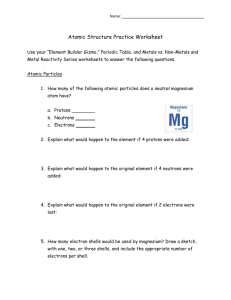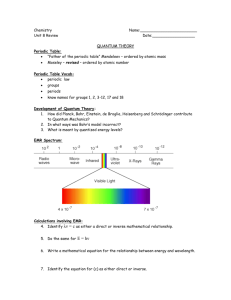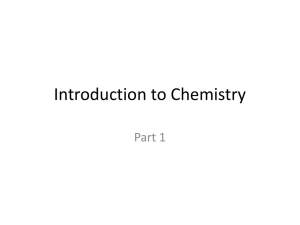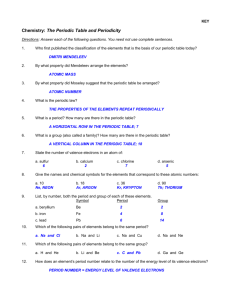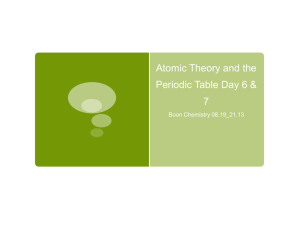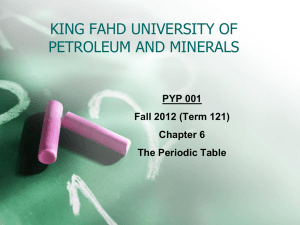Periodic Table - Mrs. Sousa`s Science Site
advertisement
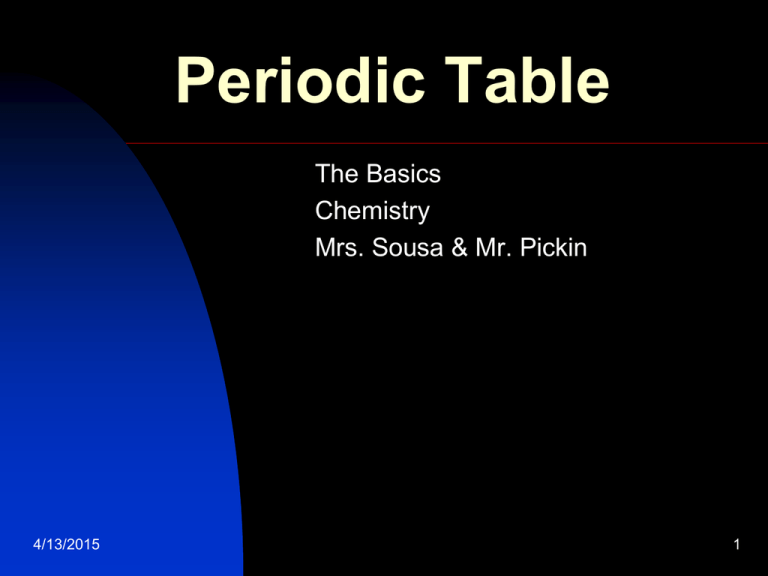
Periodic Table The Basics Chemistry Mrs. Sousa & Mr. Pickin 4/13/2015 1 Introduction 4/13/2015 This presentation will give you all the information you need to know about the basic organization of the periodic table 2 Origin 4/13/2015 The periodic table was first devised by Dmitiri Mendeleev in Russia in 1869 Based on the “Periodic Law” which states that the properties of the elements repeat periodically 3 Basics 4/13/2015 Elements listed by increasing atomic number (Unique for each element) (thus properties) Atomic number is the number of protons contained in the nucleus of an atom of an element 4 Major Divisions in Table 4/13/2015 Metals (<4 valence electrons) form + ions (cations). Ionic bonds Non-metals (>4 valence electrons) form - ions (anions). Covalent bonds Metalloids (semi-metals) Separated by zig-zag line Image 5 Periods 4/13/2015 Horizontal (across) rows are called periods. Properties of elements change across the period. 7 periods (maximum) Period number is the number of energy levels each element contains in that row (quantum # n value as well) 6 Groups/Families Either term acceptable 4/13/2015 Vertical columns 18 families Numbered from left to right Members of the same family have very similar chemical and physical properties. Atoms increase in size as you get lower in a group. 7 Representative Families. Representative families are 1,2,13, 14,15,16,17,18 Ones place is the number of valence electrons In other words- for 13-18 put your finger over the #1! Ex. Family 16 has 6 valence electrons Valence electrons are those in the outer energy level – they are used for bonding and come from the s & p orbital space Noble Gases (group #18) all have 8 valence electrons. Exception to the octet rule: He (helium) has 2 valence electrons 4/13/2015 8 Common Names 1-Alkali metals (most active metals) 2-Alkaline earth metals 16-Chalcogens 4/13/2015 17-Halogens (most active non-metals) 18- Noble gases (not reactive) 3-12 Transition metals (1 or 2 valence electrons) Lanthanide series (AN 57-71) Actinide series (AN 89-103) 9 Regions of the Periodic Table 4/13/2015 10 Group 1: Alkali Metals Reaction of potassium + H2O Cutting sodium metal 4/13/2015 11 Group 2: Alkaline Earth Metals Magnesium Magnesium oxide 4/13/2015 12 Group 17: The Halogens (salt makers) F, Cl, Br, I, At 4/13/2015 13 Group 18: The Noble (Inert) Gases He, Ne, Ar, Kr, Xe, Rn Lighter than air balloons “Neon” signs Very Unreactive because they have full electron levels 4/13/2015 XeOF4 14 Transition Metals (elements) Families 3-12 Lanthanide series click Actinide series Multivalent – can have 1, 2, 3 valence electrons – depending on what other atoms they are bonding with. 4/13/2015 15 Transition Elements Lanthanides and actinides Iron in air gives iron(III) oxide 4/13/2015 16 s, p, d, f blocks 4/13/2015 17 Atomic Radius (size) • The trend is that: •Atoms get smaller going across a period (Noble gases are the exception) •Atoms get larger going down a family 4/13/2015 18 Atomic Radius (cont.) 4/13/2015 19 Atomic Radius (cont) 4/13/2015 20 Ionization Energy (IE) The amount of energy necessary to remove one or more electrons from an atom in its gaseous state Generally: Metals have low IE Non-metals have high IE 4/13/2015 21 Ionization Energy (IE) 4/13/2015 IE increases across a period IE decreases down a family 22 Electronegativity (EN) The tendency of an atom to attract electrons (affinity for electrons) An atom's electronegativity is affected by both the positive charge in the nucleus and the distance that its valence electrons reside from the charged nucleus. The higher the associated electronegativity number, the more an element or compound attracts electrons towards it. Range of EN’s for the elements is 0.7 (Fr) to 4.0 (F) Trend: EN increases across a period and decreases down a family 4/13/2015 23 Electronegativity (EN) Trend 4/13/2015 24 Electronegativity (cont.) 4/13/2015 25 Electron Affinity 4/13/2015 The energy released when an electron is added to a neutral atom. (exothermic process) for the first added electron the process is exothermic 26

